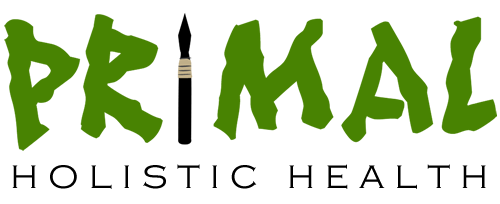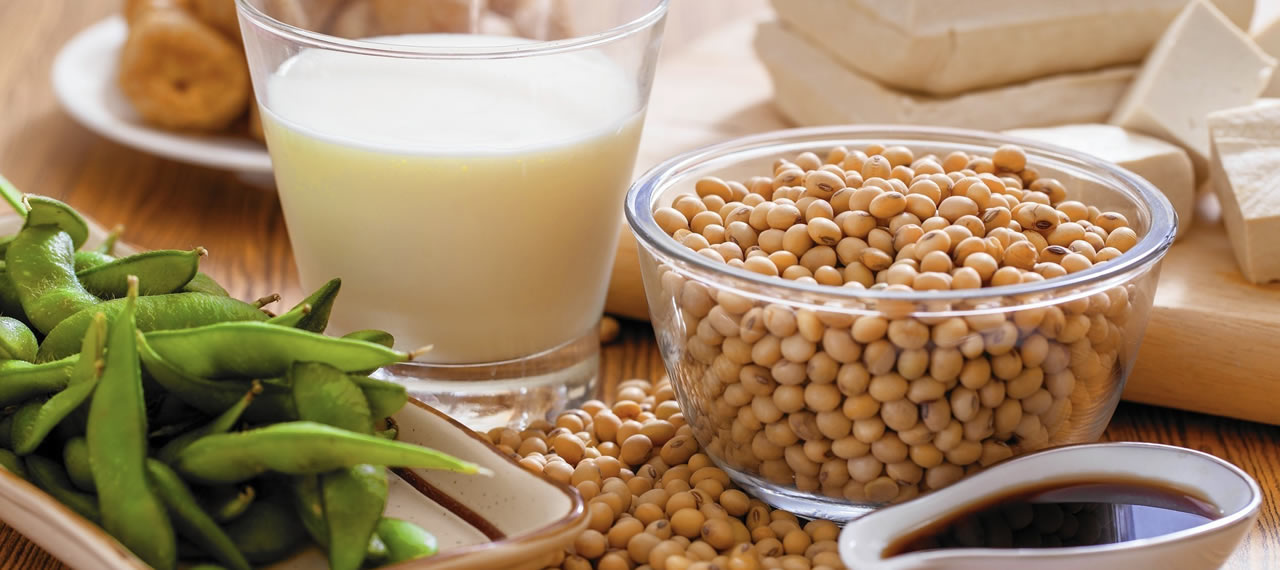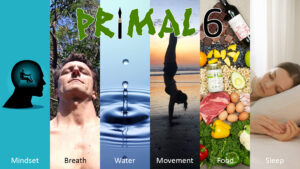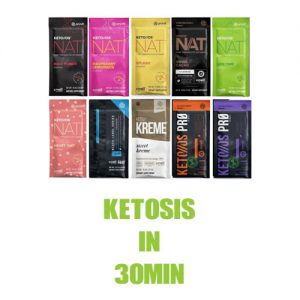Soy is all the rage these days, for the health-conscious, people avoiding dairy, and for those who just want to be on the bandwagon. Soy features in soy milks, butter-substitute spreads, soy chips, soy cheese, tofu burgers, and more. You may even be eating soy without realising it, as these days soy is in at least 60% of processed and packaged foods, including soy flours in most breads and even in canned tuna! Dr. Kaayla Daniels, author of “The Whole Soy Story”, did an interview on soy for The Healthy Life Summit, and we at Primal Health have summed up all the important bits for you right here…
70 years of studies link soy to digestive disorders, malnutrition, immune system breakdown, thyroid problems, infertility, loss of libido, heart disease and cancer. Yet these days it is heavily marketed as a health food.
How soy became known as a health food
The vegetable oil industry was using soybeans to make soy oil, and there was a lot of the soy protein leftover. Instead of just dumping these leftovers, they looked for a way to turn it into more profits. The USDA spent decades trying to figure out how to use soy protein in animal feed, but they found they could only feed the animals so much soy before the animals dropped dead prematurely or couldn’t breed. So they got the bright idea of trying to feed it to people instead. But soy didn’t have a good image. It was seen as for hippies, for poor people or for communist countries. So they decided to give it the image of a health food so rich people would be willing to spend a lot of money on it, and then poor and middle class people would want it too.
Why soy causes illness and disease
– Phytates in unfermented soy interfere with mineral absorption, leading to mineral deficiencies and disease.
– Enzyme inhibitors in soy very difficult to digest, causing digestive disorders and disease.
– Goitrogens in soy block the production of thyroid hormone leading to thyroid disorders.|
– Phytoestrogens in soy interfere with natural estrogen production and cause hormonal imbalances in the body, leading to improper development of the reproductive system and fertility issues.
– Trypsin (protease) inhibitors in soy block protein absorption.
– Most soy is genetically modified, which may lead to allergies and many other illnesses.
Soy allergies and the danger for children
The rate of soy allergies increased dramatically after the first GMO soybeans came in. Soy used to be in the top 20 list of allergens, now it’s in the top 8, and some experts think it will soon be in the top four. Allergic reactions to soy can be life-threatening. Soy and peanuts are very close to each other biologically, so many people with peanut allergies are also reacting very badly to soy. Sadly, many associations are trying to push for soynut butters for kids as a replacement for peanut butter. Kids could die from that, if they have unknowingly developed an allergy to both foods. The scientists have known these things for a long time, but get bought out by the corporations before they can speak up.
Fortunately, soy now has to be listed on the label clearly, for people with soy allergies. So read the labels! Soy lecithin is not a huge worry if you’re not allergic and not eating many foods with labels. It’s always better to just not eat food with labels. Transfer the energy you were putting into translating labels, into buying and making real food.
FDA’s soy health claims are dead wrong
Though there are massive amounts of research showing that soy does not prevent heart disease, and has actually been linked to various heart problems, the FDA approved companies to make claims that it lowers cholesterol and helps prevent heart disease. The heart healthy claim took soy sales from under a billion to up to 4 billion dollars. Clearly, the FDA is “in bed” with the soy companies to make money, just as they were with aspartame makers and numerous other corporations.
The FDA was about to approve a petition for a health claim that soy could prevent cancer, so Dr. Daniel and Dr. Enig of the Weston A. Price Foundation filed a protest citing detailed scientific evidence showing that soy could cause cancer, contribute to cancer, and accelerate the growth of cancer, particularly breast cancer. The FDA withdrew their petition and have not resubmitted.
It is hard to fight the soy industry, as they have so much money. Now, the same companies that sell supermarket milk also own some of the soy companies, so soy milk and supermarket milk are not even competitors anymore. They are in it together to make big bucks.
Isn’t soy a traditional food for healthy Asians?
– Soy goes back only about 2500 years in Asia, and was mainly used on crops as a nitrogen fixer for the soil. Poor people started to eat it, and it was discovered that if they gave it to zen monks in Asia, it would supress their sex drive and help them maintain their vow of celibacy.
– Soy can’t really be credited or blamed for any differences in cancer levels between Asians and Westerners, as there are too many other diet and lifestyle differences in Asia. Asians have lower levels of colon, breast and prostate cancer, but higher levels of esophageal, stomach, liver, thyroid and other cancers.
– Asians do not eat soy in large quantities. It is eaten as a condiment, not as a staple food in the diet. Whereas, today in many Western countries, many people are thinking that soy is a healthy substitute for quality meats and dairy and are eating it in various forms for three meals a day and snacks, plus in most of their processed foods.
– Asians mostly eat only traditional fermented soy foods, not modern processed concoctions like soy milk and tofu burgers.
Why is fermented soy better?
Fermenting the soy breaks down the phytates, enzyme inhibitors and other anti-nutrients in soy, to make it easily digestible and nutritious. Bacteria and other micro-organisms break down, or pre-digest, the complex proteins into highly digestible amino acids, sugars and fatty acids.
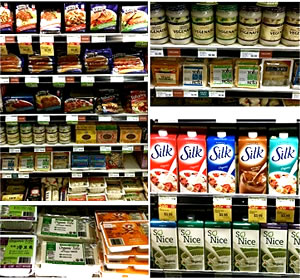
These are not traditional soy foods, just processed junk
Traditional soy foods are safe…in moderation!
These traditional soy foods are nutritious, but only when eaten as a condiment in small quantities in the diet.
Miso: 1 teaspoon miso paste makes a whole bowl of miso soup.
Natto: Very healthy fermented soy food, but the taste doesn’t appeal to most Western palates
Tempeh: Fermented soy food popular in Indonesia
Soy sauce: Traditionally fermented and unpasteurised, but many modern versions are quick fermented and pasteurised, so look for one that says raw unpasteurised.
Tofu: Unfermented, so only eat in small quantities, as Asians do
NOTE: Bragg’s Amino Acids is not a healthy product. There are residues of MSG in the fast fermentation process.
If you have thyroid or fertility issues, avoid soy as much as possible. If you are generally in good health, a little traditional soy here and there is ok.
Isn’t soy milk better than regular milk?
People are finally realising how bad commercial milk is, and in their search for an alternative, have found the chic and trendy soy milk. They may think they are lactose-intolerant, but are actually just suffering digestive problems because the pasteurised milk is so indigestible, and would probably do well on grass-fed raw milk or no milk at all. The phytates and phytoestrogens in soy milk just cause more problems, plus most soy milks have a lot of sugar in them to make them taste good. Soy milk and soy formula were NOT traditional foods in Asia. Sadly, American companies are now marketing these modern soy products in Asian countries as well.
Soy milk alternatives: raw milk and/or bone broth for calcium, minerals, digestive health and bone health. Avoid other nut milks, as they are also very over-processed with very low nutrition and cheap, hard-to-asborb nutrients added. A diet of whole plant and animal foods doesn’t need any type of milk.
Soy for vegans and vegetarians
Vegans and vegetarians are very high risk groups because soy is one of their staple foods and sources of protein. It does contain all the essential amino acids to be a protein, however not in the right levels and ratios. Plus, the trypsin (protease) inhibitors in soy actually block protein absorption. Alternatives sources of protein are eggs and raw dairy, but so many vegetarians have developed health problems that make them intolerant to dairy, eggs, etc. so they need to just slowly start eating meat. There are so many reports about people raised vegan who have massive bone loss.
Vegans think eating soy is good for the environment. On the contrary, soybeans crops have destroyed the environment in the rainforest in places like Brazil. Demanding plant based foods that come from so far away, plus all the packaging and processing makes soy very unenvironmental.
What about soybean oil?
It is very difficult to get oil from a soybean, so large factories must use dangerous hexane solvents, high temperatures and pressures, and a lot of carcinogens to extract the oil. This heavy refinement makes it rancid and smelly, so it is then artificially deodorised to be clear and flavourless. Steer clear!
What about soy infant formula for babies?
The people most at risk of damage from soy, are babies on soy infant formulas, because the babies are so small, are at key stages of development, and are getting no other nutrition from food. Babies are so harmed by soy infant formula that several government agencies in France, Israel and Germany have issued warnings that soy formula should only be used as a very last resort.
Soy affects babies’ reproductive development: Boys are estrogenised from the phytoestrogens in the soy formula and may not go through puberty and develop their male reproductive functions properly. Girls are more likely to go through puberty prematurely, develop hormonal imbalances and have menstrual and fertility issues. There are many other enviromental estrogens that contribute to this, but soy infant formula is a very dangerous factor and so should only be used a last resort. Look first into homemade baby formula.
Isn’t soy good for menopausal women?
Soy is often recommended for menopausal women, who consume it to possibly help with hot flashes. In the meantime, it is causing havoc with their thyroid, often manifesting as hypothyroidism, or underactive thyroid, which causes weight gain, lethargy, and loss of libido. Really, the possible small benefits of soy are far outweighed by the greater risks to the thyroid and for breast cancer. Several goverments and a university center for breast cancer all warn that women with high breast cancer risk should not consume much soy. Yet the soy industry is pushing soy as a prevention technique for breast cancer.
Dr. Kaayla Daniel, the “Naughty Nutritionist”
– Author of “The Whole Soy Story: The Dark Side of America’s Favorite Health Food”
– Ph.D. in Nutritional Sciences & Anti-ageing Therapies
– Certified Clinical Nutritionist
– Vice-President of Weston A. Price Foundation
– Visit www.drkaayladaniel.com for more on soy on unconventional nutrition.
What kinds of soy foods or products have you eaten? Will you continue eating them after reading this article?
Is Soy Healthy or Harmful? – April 2013
